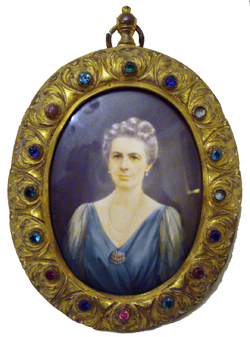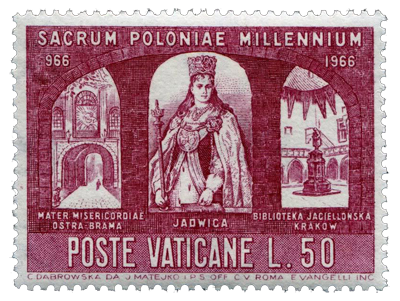|
More information about Casimira Dabrowska
|
|
|
Casimira Dabrowska, stamp designer for four popes 
Poland counts many stamp designers with a great reputation, but one of the most remarkable is surely Casimira Dabrowska. In the years between 1951 and 1969 she designed many stamps for the Vatican Post. How was it possible that, in the middle of the Cold War, a Polish artist worked for the Holy See and what kind of a woman was she, living for 35 years all alone in this mini-state, mainly inhabited by men? She was born as Kazimiera Kinga Dąbrowska in 1890 in Radom. She learned painting and drawing at schools (no academy) in Warszawa. Here she got a great skill in the arts of painting and drawing and she developed a realistic style. Soon she became a well known specialist in painting miniatures. Miniatures In the 18th and 19th century miniatures were very popular under the wealthy citizens. Miniatures carried the portrait of a loved one, living or deceased, or a famous, admired person. A miniature had the form of a small painting, often with a frame made of a precious material such as ivory. Miniatures were also made as a brooch, or lid of a pocket watch. Most miniatures were painted in a romantic or renaissance style. Casimira felt attracted to such a "style from the past". From 1914 on she participated in various exhibitions, first in Warsaw, later in Cracow and Lwów. In the years 1929, 1930 and 1931 she presented her works in Paris. In 1929 she received there an award. example of a miniature by C. Dabrowska 1946 The road to Rome In 1935 she was invited by former prime minister Ignacy Paderewski to stay some time at his estate in Switzerland. From there she made two trips to Rome. In December 1936, Casimira went once again to the Eternal City and stayed there for the rest of her life. She performed in the first few months miniature portraits of Pope Pius XI, Cardinal Eugenio Pacelli (later Pope Pius XII), Cardinal Marmaggi, the Jesuits General Vladimir Ledochowski and physicist Marconi (the inventor of radio). She quickly gained sympathy and could sell her work for a high price. In  recognition of her merits Pope Pius XI had distinguished her in 1937, giving her the Cross "Pro Ecclesia et Pontifice".
The period of the of WW II she kept painting. She created a significant amount of portraits of prominent Poles,
like major Hubal-Dobrzański and the generals Sikorski and Haller.
recognition of her merits Pope Pius XI had distinguished her in 1937, giving her the Cross "Pro Ecclesia et Pontifice".
The period of the of WW II she kept painting. She created a significant amount of portraits of prominent Poles,
like major Hubal-Dobrzański and the generals Sikorski and Haller.
Designing stamps From October 1949 to June 1950 she held an exhibition in Vatican City. She presented there 100 miniatures and 75 drawings. An exhibition in the Holy Sede was very unusual that days and this one was a big succes. One of the results must have been that Casimra got an appointment as stamp designer. The exhibition became for her the most important event but for her whole of life, as she told in an interview. In 1951 she made the first design for a Vatican stamp, together with the experienced professor Mezzana. The two stamps show the portrait of Pope Pius X and it's the only issue that doesn’t carry her name. In 1953 followed her second design with the portrait of Saint Maria Goretti. This series of three, and all the stamps that followed carried her name in very small characters: C. DABROWSKA, most of the time followed by DIS for disegnatore; designer. All together she made 64 designs, that were used for 100 different stamps. The total circulation of those stamps was 137.8 million. All stamps show her skill to create a balanced composition on a small surface. <- First stamp, signed 'C. Dabrowska' 
Two Polish items Two issues were dedicated to a Polish item: in 1956 Our Lady of Czestochowa (Matka Boska Częstochowska) and in 1966 thousand years Christianity in Poland. This series counts six stamps and is, without any doubt, her most impressing work. In a genius way, she combines historic persons and spots. Together the stamps of this series tell the story of Christianity in Poland. Very unusual: the stamps carry inscriptions in three languages: Latin (SACRAE POLONIA MILLENNIUM), Polish (the subscriptions) and Italian (POSTE VATICANE). In 1969, at the age of 79, she made her last designs: the portraits of Pius IX and Paul VI. Those last portraits were as detailed and characteristic, as all her work before. They show no trace of vanishing talent. 
One of the stamps "1000 years christianity in Poland"
Who was Casimira Dabrowska? Still remains the question: what kind of a woman was she? On a self portrait we see a young woman, elegantly dressed. She looks modest. We now that stayed unmarried all her life and seemed to give all her energy to painting and drawing of miniatures and stamp designs. Sam Derry, a British intelligence officer, met her in occupied Rom in 1944. In his memoirs he writes:"She was distressed because she was trapped in the Vatican and practically had no contact with the outside world, and was unable to help the organization." Derry means his organization for liberating English
Dabrowka's last design and last stamp.
prisoners.
When Casimira sees a portrait of Derries wife on the backside of his wrist-watch,
she offers him to make a larger copy of it. Derry goes on: "Two days later, the result
was a magnificent drawing, which I always shall treasure, a glowing, lifelike portrait."
Throughout her stay in the Eternal City she occupied a cell in the monastery of the Sisters of St. Joseph of Cluny.
The interior of the cell was as simple as the cells of the sisters. On the wall was a portrait of Pius XII.
Through her window she could see the dome of Saint Peters Basilica.
Maybe it was an important symbol for the unique connection she had with the church and it's leaders.
She served four popes as an artist. She died 1 February 1972. Casimira was buried the 5th February,
according to her wish, on the cemetery near the Via Flamina, from where one could see,
in the distance, the dome of the Saint Peter's Basilica.....

 A coincidence?
A coincidence?Casimira Dabrowska made this portrait of duchess Dąbrówka for a stamp in 1966 (left). Not only the names are almost similar, this portrait resembles the self-portrait of Casimira from 1937. Look at the previous page. It is created after a drawing by Jan Matejko (right), but Dąbrówka on the stamp looks more friendly than the one on the drawing. Is it coincidence? I don't think so.
|
This work is licensed under a Creative Commons Attribution-NonCommercial 3.0 Unported License